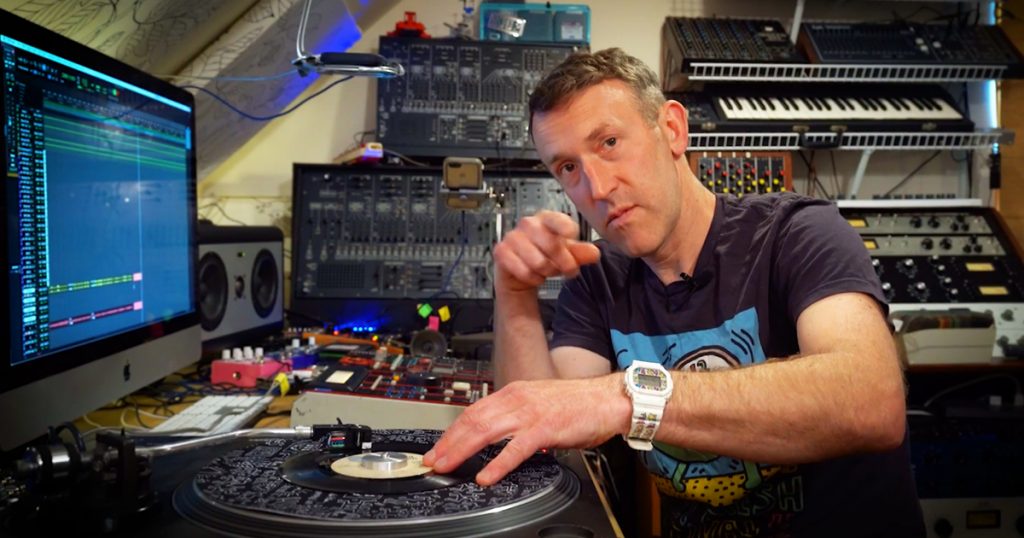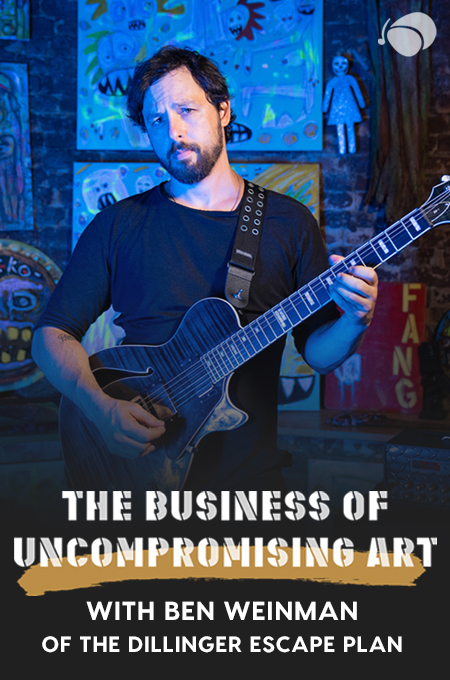+ This video lesson is presented courtesy of RJD2’s course, RJD2: From Samples to Songs. Sign up and learn to create and arrange original, instrumental hip-hop music from a true sampling pioneer!
Article premiered by the ASCAP Blog
RJD2’s exclusive Soundfly course, From Samples to Songs, covers sampling from a variety of angles and approaches, the historical context and evolution of hip-hop music and sample-based composition, and how you can learn to write and arrange sampled tracks into full songs both on the MPC and in your DAW.
Along the way, RJ (Ramble Jon Krohn) breaks down some of his most beloved tracks, extrapolating his philosophies and perspectives from his creative process, and workflow management techniques in real time.
In this post, courtesy of our friends at ASCAP, we’re excited to share a video lesson from the course, wherein RJ shares how to get the most out of short periods of highly constrained creativity. RJ is known for moving quickly through base loops and ideas, and this video offers a window into his process for how to get them to a usable state more quickly. Enjoy!
An important element of RJD2’s process is moving quickly, coming up with lots of ideas, and then revisiting them later to decide which ones to push forward. From the video above, we can pull out a few core elements to his process:
- Embrace quantity over quality. RJ sometimes makes up to 10 beats in a single day.
- Get to an idea fast, then move on. RJ wants to avoid over-thinking an idea, so he’s focusing on the idea over execution at this point. Don’t spend too much time tinkering upfront.
- Don’t overlisten to it. If he listens to an idea too much, he might trick himself into loving it or get overly attached to it.
- Refresh your ears. RJ will often walk away from a beat, maybe even listen to something else, then come back again with new ears to see if he likes it.
One goal for RJ in terms of evaluating which song ideas to pursue is to try to achieve some sort of objectivity. In other words, he’s attempting to listen with his audience in mind.
“Ultimately, I’d rather have a poorly executed version of a good idea, than a great-executed version of a mediocre idea…At the end of the day, it’s the idea, which is the part that I’m taking.”

Let’s check out specifically how a few of his songs’ “origin stories” — how they came to be. A few of them provide great examples of how a sampling mindset can have a big impact on your music, even if you don’t end up sampling a record directly.
“1976”
This track from Since We Last Spoke came about by pairing two samples that didn’t initially seem to fit together. While searching for sounds to load up in the MPC, he came across a powerful horn sample that would be the catalyst for the hook and the core idea the rest of the track would be built around.
But it wasn’t quite enough, so he went digging for something else to add to the top end of the track to really tie the hook components together. What he found was that haunting and evocative vocal sample. On first listen, he thought it might make the track sound too busy, but instead, it ended up tying the harmony of the track together and helped things build to a critical emotional density.
Origin story lesson: Don’t write off an idea just because you think it won’t fit. Sometimes, parts that seem like they’ll clash end up offering exactly what’s needed and taking the track to a new level.
“Sometimes I’ll just hit record, and go…without really thinking about what this is going to become.”
+ Read more on Flypaper: “‘Synthetic Substitution’ — How RJD2 Samples Soul Records.”
“Indoor S’mores”
Much of the creative process that went into RJ’s latest record, The Fun Ones, was about trying to make live instruments feel like samples. The track “Indoor S’mores” does exactly that. Instead of working with his MPC, RJ started this track at the drum kit, jamming by himself.
He was trying to come up with his own take of one of the most sampled drum breaks of all time: Clyde Stubblefield’s break from James Brown’s “Funky Drummer.”
This is a great example of drawing on a sampling mindset, even though RJ is using a live instrument.
Origin story lesson: We don’t need to be sampling purists. Sometimes you can make your own sample on an instrument — or come up with a part inspired by a sample.
“Peace of What”
As a relentlessly curious artist, RJ will often sit down and use his Fender Rhodes to help him dissect a track he loves. Instead of listening only for samples, he’s exploring the arrangement, harmonic choices, instrumentation, melodies, rhythms, etc.
In the case of “Peace of What,” he was exploring an idea he heard on a record, but it ended up inspiring a new idea. Instead of just sampling the original part on the record, he took the idea and turned it into a new part that was reinterpreted from the original, and then used that to create a new song.
Origin story lesson: Sometimes you don’t have to lift a part directly. Instead, you can use it to inspire a completely new and different idea.
“If I can put the thing away, get out of that headspace, and then come back with fresh ears, at that point I can oftentimes assess what’s worth pursuing and what’s not.”
+ Read more on Flypaper: “4 Classic Breakbeats That Changed Hip-Hop History.”
“The Freshman Lettered”
RJ is often tapped to write music for ads, films, and television. Most of the time, these opportunities are done on spec, which means that as the writer, he creates something for the gig in question and is only paid if the track ends up being used. Because he only makes music he’s willing to put his name on, he sees this as an opportunity for some new material — whether it gets selected or not.
“The Freshman Lettered” started as a pitch for a Diet Coke commercial. Because he stuck to his artistic convictions, it became something he was proud to release even though it wasn’t used for the ad.
Origin story lesson: Stay true to your artistic principles with every project you take on. Your music won’t end up being a fit for everything, but it will be yours, and who knows what you’ll end up with?

Come up with as many song kernels as you can in 30 minutes.
Pull together your music-making set up, put 30 minutes on the clock, and try to come up with as many short song ideas as you can. They can be anything from a few chords and a beat to a song section with a hook.
The essential piece of this activity is to stop each new idea the moment you’ve captured it and move onto something new. That means staying away from mixing and sound design or dialing in just the right tone on your instrument. Capture, save, repeat.
Once you’ve reached your limit, save your ideas and set them aside for at least a day. Then, come back with fresh ears and see whether any of them might be worth fleshing out a bit further.
Ready to Learn From RJD2 Himself?
Learn from instrumental hip-hop producer/sampling pioneer RJD2, how to write and arrange music drawing on the power of sampling records and a collage-based mindset. He’ll show you how he personally tackles new tracks with his trusty MPC, and he’ll open up sessions from some of his classic tracks to show how they were made. You’ll learn new approaches to sampling, songwriting, and arranging, and how to make instrumental beats that capture someone’s attention from start to finish.
Join RJD2: From Samples to Songs today.




